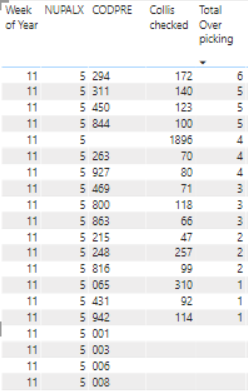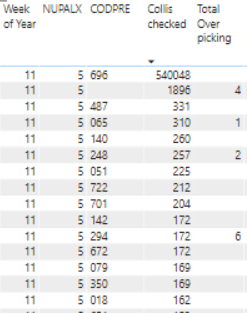Become a Certified Power BI Data Analyst!
Join us for an expert-led overview of the tools and concepts you'll need to pass exam PL-300. The first session starts on June 11th. See you there!
Get registered- Power BI forums
- Get Help with Power BI
- Desktop
- Service
- Report Server
- Power Query
- Mobile Apps
- Developer
- DAX Commands and Tips
- Custom Visuals Development Discussion
- Health and Life Sciences
- Power BI Spanish forums
- Translated Spanish Desktop
- Training and Consulting
- Instructor Led Training
- Dashboard in a Day for Women, by Women
- Galleries
- Webinars and Video Gallery
- Data Stories Gallery
- Themes Gallery
- Contests Gallery
- Quick Measures Gallery
- Notebook Gallery
- Translytical Task Flow Gallery
- R Script Showcase
- Ideas
- Custom Visuals Ideas (read-only)
- Issues
- Issues
- Events
- Upcoming Events
Power BI is turning 10! Let’s celebrate together with dataviz contests, interactive sessions, and giveaways. Register now.
- Power BI forums
- Forums
- Get Help with Power BI
- DAX Commands and Tips
- Top and Bottom 5 with RANKX based on other measure...
- Subscribe to RSS Feed
- Mark Topic as New
- Mark Topic as Read
- Float this Topic for Current User
- Bookmark
- Subscribe
- Printer Friendly Page
- Mark as New
- Bookmark
- Subscribe
- Mute
- Subscribe to RSS Feed
- Permalink
- Report Inappropriate Content
Top and Bottom 5 with RANKX based on other measures
Hi all,
I need to calculate a top and bottom 5 employees based on the result of two measures.
I tried to use RANKX but the problem is that I need to take into account two measures. Like a double ranking...
Below 3 examples:
'Collis checked' and 'Total Over Picking' are measures
1)  2)  3)  | 1) Show the BOTTOM 5 'GOLD numbers bereider' with the most 'total over picking'. (!) Take into consideration who has the most 'collis checked'. (!) Total over picking can be BLANK or contain a number In the example left this is the desired result: 1. 294 2. 311 3. 450 4. 844 5. blank 2) Show the TOP 5 'GOLD numbers bereider' with the less 'total over picking'. (!) Take into consideration who has the most 'collis checked'. (!) Total over picking can be BLANK or contain a number In the example left this is the desired result: 1. 065 2. 431 3. 942 4. 248 5. 816 3) Show the TOP 5 'GOLD numbers bereider' with the less 'total over picking'. (!) Take into consideration who has the most 'collis checked'. (!) Total over picking can be BLANK or contain a number In the example left this is the desired result: 1. 696 2. 487 3. 140 4. 051 5. 722 |
I created a test powerbi file with sample data. You can download the test file via this link in WeTransfer: https://we.tl/t-tr6d0dzIQH
Hope someone can help out. I already broke my head hours on this one... 😞
Solved! Go to Solution.
- Mark as New
- Bookmark
- Subscribe
- Mute
- Subscribe to RSS Feed
- Permalink
- Report Inappropriate Content
Hi, @Anonymous
For your last requirement, please try formula as below:
Ranking =
RANKX (
ALLSELECTED( Data[CODPRE] ),
RANKX ( ALLSELECTED( Data[CODPRE] ), [Total Over picking],,DESC )
+ DIVIDE (
RANKX ( ALLSELECTED( Data[CODPRE] ), [Collis checked],,DESC ),
COUNTROWS ( ALLSELECTED( Data[CODPRE] ) ) + 1
)
,,
ASC,
DENSE
)Ranking(<5) =
IF([Ranking]<=5,[Ranking],BLANK())
Please check my sample file for more details.
Best Regards,
Community Support Team _ Eason
- Mark as New
- Bookmark
- Subscribe
- Mute
- Subscribe to RSS Feed
- Permalink
- Report Inappropriate Content
@Anonymous , File seem to have some different data. you need try like
top and bottom 5 = CALCULATE([Total Over picking],TOPN(5,ALLSELECTED(Data[CODPRE]),[Total Over picking],DESC),VALUES(Data[CODPRE]))+ CALCULATE([Total Over picking],TOPN(5,ALLSELECTED(Data[CODPRE]),[Total Over picking],ASC),VALUES(Data[CODPRE]))- Mark as New
- Bookmark
- Subscribe
- Mute
- Subscribe to RSS Feed
- Permalink
- Report Inappropriate Content
hi @amitchandak , your proposed solution is not exactly what I try to obtain

| Your 'top and bottom 5' returns the value of the 'total over picking'. I would like it to return a ranking (number 1 to 5).
Also if the top 5 of the 'total over picking' contains several times the same value then it should look at the 'collis checked' measure to rank those values.
In the left example: top 5 result would be
|
You know how I can do this? 🙂
Thanks!
- Mark as New
- Bookmark
- Subscribe
- Mute
- Subscribe to RSS Feed
- Permalink
- Report Inappropriate Content
Hi, @Anonymous
For your last requirement, please try formula as below:
Ranking =
RANKX (
ALLSELECTED( Data[CODPRE] ),
RANKX ( ALLSELECTED( Data[CODPRE] ), [Total Over picking],,DESC )
+ DIVIDE (
RANKX ( ALLSELECTED( Data[CODPRE] ), [Collis checked],,DESC ),
COUNTROWS ( ALLSELECTED( Data[CODPRE] ) ) + 1
)
,,
ASC,
DENSE
)Ranking(<5) =
IF([Ranking]<=5,[Ranking],BLANK())
Please check my sample file for more details.
Best Regards,
Community Support Team _ Eason
- Mark as New
- Bookmark
- Subscribe
- Mute
- Subscribe to RSS Feed
- Permalink
- Report Inappropriate Content
Thank you @v-easonf-msft! That measure is exactly what I needed!
Would never have been able to figure that out all by myself 😳
Helpful resources

Join our Fabric User Panel
This is your chance to engage directly with the engineering team behind Fabric and Power BI. Share your experiences and shape the future.

Power BI Monthly Update - June 2025
Check out the June 2025 Power BI update to learn about new features.

| User | Count |
|---|---|
| 14 | |
| 10 | |
| 10 | |
| 9 | |
| 9 |
| User | Count |
|---|---|
| 20 | |
| 13 | |
| 12 | |
| 11 | |
| 8 |

